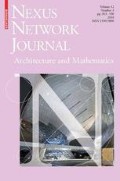Abstract
From its early origins to the tenth century, the Hindu temple embodied a progressive elaboration of a simple formal schema based on a cuboidal sanctum and a solid form of distinctive curvature. The architectural form of the temple was the subject of wide experimentation, based on canonical sacred texts, within the regional schools of temple building in the Indian subcontinent. This paper investigates the practice of this knowledge in the constructive geometry of temple superstructures, with attention focused on the canonical rules for deriving the planar profile of a temple using a mandala (proportional grid) and the curvature of the sikhara (superstructure) using a rekha sutra (curve measure). This paper develops a mathematical formulation of the superstructure form and a detailed three-dimensional reconstruction of a tenth-century superstructure, based upon computational reconstructions of canonical descriptions. Through these reconstructions, the paper provides a more complete explanation of the architectural thinking underlying superstructure form and temple ornamentation.
Preview
Unable to display preview. Download preview PDF.
References
Acharya, P. 1980. The architecture of the Mansara, 2 vols. New Delhi: Manohar Publishers.
Affleck, J. and T. Kvan. 2005. Reinterpreting Virtual Heritage. Pp. 69–178 in vol. 1 of Proceedings of the Tenth Conference on Computer-Aided Architectural Design Research in Asia, A. Bhatt, ed. New Delhi: TVB School of Habitat Studies.
Bafna, S. 2000. On the idea of the Mandala as a governing device. Journal of the Society of Architectural Historians 59,1: 26–49.
Bhatt, R. 1981. Brhat Samhita of Varahamihira, 2 vols. New Delhi: Motilal Banarsidass.
Boner, A., Sadasiva Ram Sarma, and B. Baumer. 2000. Vastusutra Upanisad:the Essence Of Form In Sacred Art (text in Sanskrit with English translation and notes). New Delhi: Motilal Barnasidass.
Chandra, P., ed. 1975. Studies in Indian Temple Architecture. Varanasi: American Institute of Indian Studies.
Dagens, B. 1995. Mayamata: An Indian treatise on Housing Architecture and Iconography. New Delhi: Sitaram Bhartia Institute of Science and Research.
Daigoro, Chihara. 1996. Hindu Buddhist Architecture in Southeast Asia. Leiden: E. J. Brill.
Datta, Sambit. 1993. Geometric Delineation in the Nâgara Cella: Study of the temple of Ranakdevi at Wadhwan, Ph.D. thesis, School of Architecture, CEPT. Ahmedabad: Vastu Shilpa Foundation.
1. 1994. Modelling Sikhara form in the Maha-gurjara idiom. Michael Ventris Research Report, Institute of Classical Studies. London: Cambridge and Architectural Association (AA).
2. 2001. Infinite Sequences and the Form of Cella Superstructures. Pp. 106–112 in The Proceedings of the Third International Conference on Mathematics and Design, Geelong, Deakin University.
3. 2005. On Recovering the Surface Geometry of Temple Superstructures. Pp. 253–258 in vol. 2 of Proceedings of the 10th International Conference on Computer Aided Architectural Design Research in Asia, Bhatt, A., ed. New Delhi: TVB School of Habitat Studies.
Datta, S. and D. Beynon. 2008. Compositional Connections: Temple Form in Early Southeast Asia. In History in Practice, Society of Architectural Historians Australia New Zealand [DVD Publication]. Geelong.
Debevec, P., C. Taylor, and J. Malik. 1996. Modeling and rendering architecture from photographs: A hybrid geometry and image-based approach. Pp. 11–20 in Proceedings of SIGGRAPH 1996.
Dhaky, M. 1961. The chronology of the Solanki temples of Gujarat. Journal of Madhya Pradesh Itihasa Parishad 3: 1–83.
Evans, R. 1995. The Projective Cast: Architecture and Its Three Geometries. Cambridge, MA: MIT Press.
Hardy, A. 2002. Sekhari Temples. Artibus Asiae 62,1: 81–138.
Kramrisch, S. 1946. The Hindu Temple, 2 vols. Calcutta: University of Calcutta.
Meister, M. W. 1976. Construction and conception of mandapika shrines of central India. East and West, New Series 26: 409–418.
1. 1979. Mandala and practice in Nâgara architecture in northern India. Journal of American Oriental Society 99,2: 204–219.
2. 1986. On the development of a morphology for a symbolic architecture: India. Anthropology and Aesthetics 12: 33–50.
Michell, G. 1977. The Hindu Temple: An Introduction to its Meaning and Forms. London: Harper & Row.
Streilein, A. and M. Niederöst. 1998. Reconstruction of the Disentis monastery from high resolution still video imagery with object oriented measurement routines. International Archives of Photogrammetry and Remote Sensing 22,pt. 5: 271–277.
Author information
Authors and Affiliations
Editor information
Rights and permissions
Copyright information
© 2010 Kim Williams Books, Turin
About this chapter
Cite this chapter
Datta, S. (2010). Infinite Sequences in the Constructive Geometry Of Tenth-Century Hindu Temple Superstructures. In: Kirkbride, R. (eds) Geometries of Rhetoric. Nexus Network Journal, vol 12,3. Birkhäuser, Basel. https://doi.org/10.1007/978-3-0346-0522-9_8
Download citation
DOI: https://doi.org/10.1007/978-3-0346-0522-9_8
Publisher Name: Birkhäuser, Basel
Print ISBN: 978-3-0346-0521-2
Online ISBN: 978-3-0346-0522-9
eBook Packages: Mathematics and StatisticsMathematics and Statistics (R0)

